
95% of researchers rate our articles as excellent or good
Learn more about the work of our research integrity team to safeguard the quality of each article we publish.
Find out more
ORIGINAL RESEARCH article
Front. Environ. Sci. , 18 April 2023
Sec. Biogeochemical Dynamics
Volume 11 - 2023 | https://doi.org/10.3389/fenvs.2023.1157101
This article is part of the Research Topic Biogeochemical Dynamics in Urban Systems: Interactions, Feedbacks, and Cumulative Impacts View all 9 articles
 Ahmed A. Al-Taani1,2*
Ahmed A. Al-Taani1,2* Yousef Nazzal1
Yousef Nazzal1 Fares M. Howari1
Fares M. Howari1 Jibran Iqbal1
Jibran Iqbal1 Muhammad Naseem1
Muhammad Naseem1 Manish Sharma1
Manish Sharma1 Cijo Xavier3
Cijo Xavier3 Dimitrios Papandreou1
Dimitrios Papandreou1 Lina Maloukh1
Lina Maloukh1 Lakshmi Ambika1
Lakshmi Ambika1 Imen Ben Salem1
Imen Ben Salem1 Abeer Al Bsoul4*
Abeer Al Bsoul4* Haitham M. Farok5
Haitham M. Farok5The metal composition of road-deposited dust along the Abu Dhabi-Liwa Highway was investigated to provide insight into the contamination profile and levels of road dust. The average concentrations of metals decreased in the order Al (28668 ± 4631 mg/kg)> Fe (21461 ± 2594 mg/kg) > Mn (711.8 ± 76.3 mg/kg) > Zn (210.6 ± 51.6 mg/kg) > Cu (94.9 ± 15.8 mg/kg) > Pb (83.6 ± 5.3 mg/kg) > Cd (75.1 ± 1.6 mg/kg) > Co (62.6 ± 6.4 mg/kg) > As (4.7 ± 2.9 mg/kg) > Ni (0.10 ± 0.19 mg/kg) > Cr (0.08 ± 0.06 mg/kg). The spatial variations of metals suggest different sources and contributing factors for these metals, with most dust metals having mixed traffic and non-traffic origins. The contamination factor (CF) and enrichment factor (EF) showed identically the same order, Cd> Pb> As> Zn> Co> Cu> Mn> Ni> Cr, whereas the geoaccumulation index (Igeo) follows a slightly different ranking, Cd> Pb> Zn> Co> As> Cu> Mn> Ni> Cr. Based on EF and CF levels, roadway dusts are enriched in all metals, except for Ni and Cr. Similarly, the average Igeo values show differing rates of pollution for all metals except for Mn, Ni, and Cr. All pollution indicators suggest extreme pollution with Cd. The pollution loading index values showed sites 1–10 are generally polluted, while sampling sites from 11 to 19 are unpolluted with decreasing pollution loadings. Dusts collected from both sides of highway were higher in metal content than those obtained from the central reservation area. This may be due to the prevailing southeast wind direction, resuspension of road dust, and farmlands, among others. Soils bordering the highway showed high metal contents with potential consequences on the agricultural products.
Concern over the contributions of roadside dust to public health is escalating worldwide, and the United Arab Emirates (UAE) is no exception (Al-Taani et al., 2019b; Nazzal et al., 2021a; Maloukh et al., 2023). The road network system in the UAE has significantly increased from 4080 km in 2008 to about 18255 km in 2020. This coincided with a growing number of vehicular fleets. As such, residents are increasingly exposed to vehicle exhaust and non-exhaust emissions, especially those living in the vicinity of highways and the road users (Al-Taani et al., 2019a; Nazzal et al., 2021b).
High metal contents (and enrichment) were reported in road dust in many parts of the world, especially in urbanized areas, and have primarily been attributed to the traffic-related emissions (Al-Taani et al., 2019a). Vehicular emissions include complex mixtures of metals that accumulate in roadside dust and soil (Al-Taani et al., 2019a). These metals can originate from tires, brakes, fuel, and engine oil, among others. In addition, numerous other metals have been introduced into the environment due to the recent development of automotive products and technologies. The elemental composition of roadside dust may also be derived from diverse geogenic sources (Al-Taani et al., 2018; El-Radaideh and Al-Taani, 2018).
Metals in urban road deposited dust can provide information about the local environment and the regional sources (Cai and Li, 2019). The background levels of metals in ambient air in the UAE are likely elevated as the country is influenced by multiple emission sources (Al-Taani et al., 2019a). In addition to the local sources of metals, such as industrial activities and the transportation sector, the UAE is affected by wind-blown dust enriched in metals that originates from the Arabian Gulf region, especially when the north-westerly winds become predominant (Al-Taani et al., 2019b; Nazzal et al., 2019). The Arabian Gulf is home to one of the world’s largest oil and gas reserves, with refineries and petrochemical industries that emit substantial amounts of metals into the atmosphere (Al-Taani et al., 2014; Batayneh et al., 2014; Nazzal et al., 2021a). Airborne metals can be transported from the emission sources in the Arabian Gulf region to the UAE (Al-Taani et al., 2019b). These atmospheric metals may be subjected to deposition and accumulation in roadside soil and dust. The impact of long-range atmospheric transport of metals will probably intensify due to climate change as the climate models consistently project that the region is prone to increasing aridity and drought frequency, with implications for severe and extended episodes of dust storms (Al-Taani et al., 2015b). Metals emitted into the atmosphere by human activities may deposit in the vicinity of the emission area but can also be deposited “en route” during their long-range transport (Petersen, 1999; Al-Taani et al., 2015b). Despite many efforts made to regulate and control exhaust vehicular-emitted metals, legislation relevant to non-exhaust pollution sources is lacking.
This study provides a detailed analysis of metal content in dusts and soils collected from the Abu Dhabi–Liwa Highway and assesses the level and profiles of contamination. About 123 km of the highway were sampled to unveil any spatial variations in metal content and assess their potential sources and contributing factors to the observed levels of metal contents in road dust. Heavy metals in soils bordering the highway were assessed for the long-term impact of vehicular emissions.
The study area is located between Abu Dhabi and Liwa and is characterized by prevailing arid conditions. The area is covered by aeolian dunes of the Holocene and Pleistocene eras that dominate the surface geology. It contains an extensive sand and gravel plain with a thick blanket of aeolian dunes. The majority of Abu Dhabi Emirate soils are sandy, sandy calcareous, gypsiferous, saline, saline gypsiferous, and hardpan soils. Sandy desert soils (Entisols) are dominant, followed by Aridisols and Inceptisols to a relatively lesser extent (Shahid and Abdelfattah, 2008). The Liwa area hosts a large shallow groundwater aquifer that has been overused for irrigation.
Nineteen sites were sampled for road dust alongside the Abu Dhabi-Liwa Highway in February 2021 (Figure 1). It is a relatively busy highway with high traffic loads. The length of the area sampled is about 123 km, and the majority of samples were obtained from the accumulated dust near the road’s edge and trapped by the road concrete pavement. In sites where pavements are absent, dust was carefully collected from the top few centimeters of roadside soil. In some selected locations, soil adjacent to the highway was collected and analyzed.
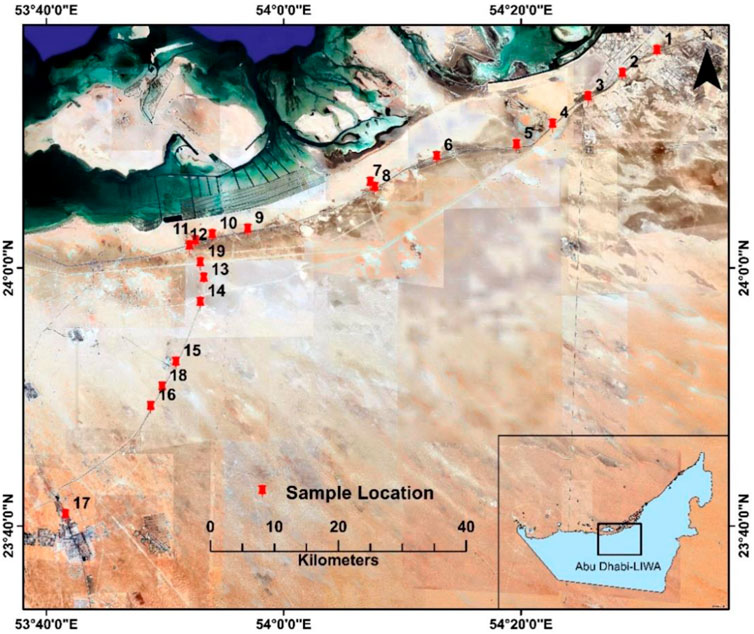
FIGURE 1. Location map of the roadside dust sampling sites obtained along the Abu Dhabi-Liwa Highway.
The sampling sites were chosen from both sides of the highway and central reservation area to investigate the potential impacts of the prevailing wind direction and the spatial variability. Sampling sites were selected based on accessibility, intersections, topography, susceptibility to wind impact, and proximity to farmlands and trees/shrubs that act as windbreaks. These sites are located at varying distances (from 0 to 50 m) off the highway. Samples were obtained by gently sweeping with a polyethylene brush, kept in plastic bags, and transported to the laboratory after labeling. Sample locations were positioned with a portable GPS meter. All samples were air-dried and sieved through a 2-mm sieve to allow for the removal of plants, debris, and other objects. Then, 200 mg of the sample was acid-digested in 6 mL HNO3, 2 ml HCl, and 2 ml HF and heated at 150°C for about 40 min. The digested mixture was filtered through Whatman filter paper No. 42, where the filtered digest was then transferred to a 50-ml plastic volumetric flask and filled up to the mark with deionized water. The metal composition of dusts and soils was measured by Agilent 700 series ICP-OES. A certified reference material (CRM) (IAEA soil-7) was used for validation. Detection limits and accuracy details are tabulated in Table 1. All samples were run in duplicate, and values were averaged. Analytical blanks were run simultaneously, and concentrations were measured using standard solutions prepared in the same acid matrix (to double-check for any contaminations during digestion and analysis). The accuracy was assessed by analyzing NIST 1646, a standard reference material.
Dusts were analyzed for anions and cations as follows: 0.8 g sample was added to 8 ml of Milli-Q water, and the mixture was shaken, sonicated for 50 min, centrifuged, and filtered through a 0.45-μm disc syringe filter. The Thermo ICS-5000+ (Waltham, MA, United States) ion chromatography system was used throughout this work. Instrument control and data acquisition were performed using Chromeleon® software. The ICS-5000+ system, coupled with two different eluent pumping systems, suppressors, columns, and detectors, was used for the simultaneous separation of anions and cations. A 25-μl sample loop was used for all the work.
Anionic (SO4 and NO3) separation was performed on a Thermo™ IonPac™ AS17 column (250 mm, 4 mm ID) used with a Thermo AG17 guard column (50, 4 mm ID), coupled to a Thermo ERS AERS 500- 2 mm suppressor. Hydroxide eluent gradients were generated online using the Thermo EGC-KOH Potassium Hydroxide Eluent Generator Cartridge. Isocratic flow was used throughout the analysis. For the cationic (Ca, Mg, Na, and K) determination, analysis was performed on a Dionex™ IonPac™ CS12 column (250, 4 mm ID), preceded by a Dionex CG12 guard column (50, 4 mm ID), in series with a Thermo ERS AERS 500- 2 mm suppressor. Methanesulfonic acid eluent gradients were generated online using the Thermo EGC-MSA Methanesulfonic Acid Eluent Generator Cartridge. Eluents used were pre-filtered through 0.45-μm nylon membrane filters (Phenomenex, Sydney, Australia).
The enrichment factors (EF) help distinguish crustal and natural sources of metals from those of anthropogenic origin (El-Radaideh et al., 2014). The EF of metals in road dust was estimated relative to their abundance in the upper continental crust (Yardley, 1986) (Table 2) using the following equation:
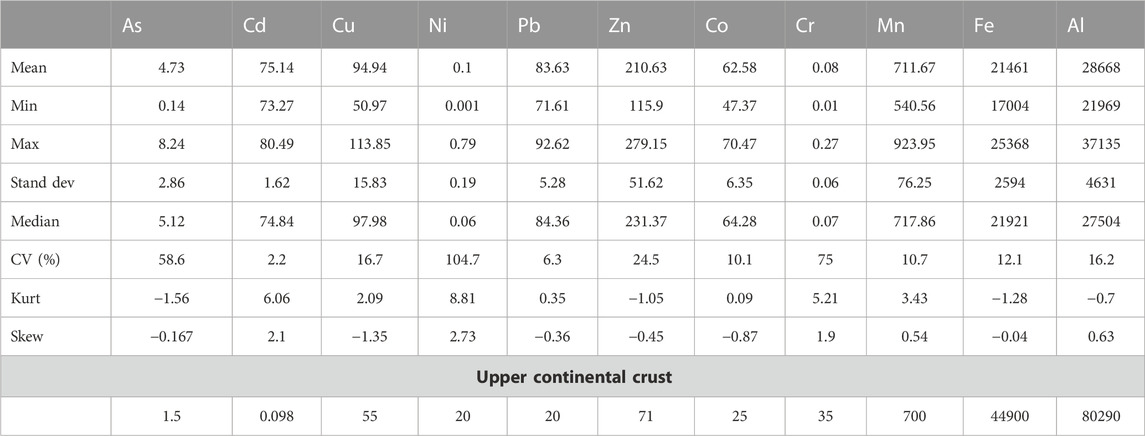
TABLE 2. Basic statistics of the metal contents of road dust obtained from the Abu Dhabi-Liwa Highway (mg/kg).
where the M/Al sample is the ratio of the metal (M) content to Al in dust samples and M/Al crust is their relative ratio in the upper crust (Tab1e 1). Al was used as the normalization reference element because it is abundant in the continental crust. Samples were classified as minimal enrichment (EF<2), moderate enrichment (2≤EF<5), significant enrichment (5≤EF<20), very high enrichment (20≤EF<40), and extremely high enrichment (EF≥40) (Yongming et al., 2006).
The geo-accumulation index (Igeo) is also used to assess the intensity of metal contamination in road dust. Igeo was estimated using the following equation (Mueller et al., 1993):
where Cn is the concentration of n-metal in dusts and Bn is the geochemical background concentration of n-metal. Here, 1.5 is the correction factor of the background matrix. The Igeo index consists of seven classes (Mueller et al., 1993): unpolluted (Igeo≤ 0), unpolluted to moderately polluted (0<Igeo≤1), moderately polluted (1<Igeo≤2), moderately to heavily polluted (2<Igeo≤3), heavily polluted (3<Igeo≤4), heavily to extremely polluted (4<Igeo≤5), or extremely polluted (Igeo≥5) (Mueller et al., 1993).
The contamination level of road sweepings for metals is further assessed by the contamination factor (CF), which enables the determination of the degree of metal pollution in dusts (Hakanson, 1980). The CF is the concentration of metal divided by the baseline or background value (Hakanson, 1980). Samples were classified as low contamination (CF˂1), moderate contamination (1≤CF˂3), considerable contamination (3≤CF≤6), and very high contamination (CF˃6) [20]. The average abundance in the upper continental crust was used as the background values for Igeo and CF.
Dust samples were also evaluated by the pollution load index (PLI) of metals using the following equation (Tomlinson et al., 1980):
where CF is the calculated contamination factor and n is the number of metals. Based on Tomlinson et al. (1980) the PLI is classified as contaminated (PLI>1), at baseline level (PLI = 1), or not contaminated (PLI<1).
The concentrations of As, Cd, Cu, Ni, Pb, Zn, Co, Cr, Mn, Fe and Al, along with Ca, Mg, Na, K, Cl, SO4, and NO3 in Abu Dhabi-Liwa Highway dusts are summarized in Tables 2, 7 and are presented in Figures 2–4. Overall, the variability of metal contents in road-deposited dust suggests different sources and contributing factors for these metals. The largest variations were observed for Ni by a factor of 791 (difference between the highest and lowest values), although Ni concentration is consistently below 0.8 mg/kg for all dust samples. As and Cr showed relatively large variations by factors 59 and 22, respectively. Cu, Zn, Mn, and Al varied by factor 2, whereas the lowest variations (by factor 1) were reported for Cd, Pb, Co, and Fe.
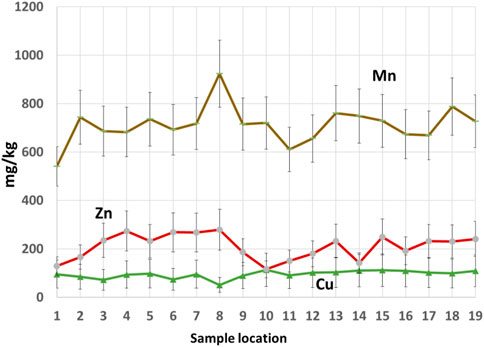
FIGURE 2. Spatial distribution of Mn, Zn, and Cu in dusts collected from the Abu Dhabi-Liwa Highway.
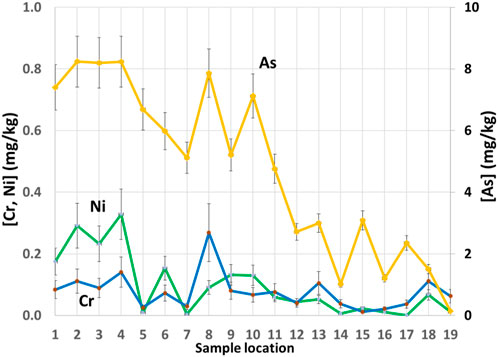
FIGURE 3. Spatial distribution of As, Ni and Cr content in dusts collected from the Abu Dhabi-Liwa Highway.
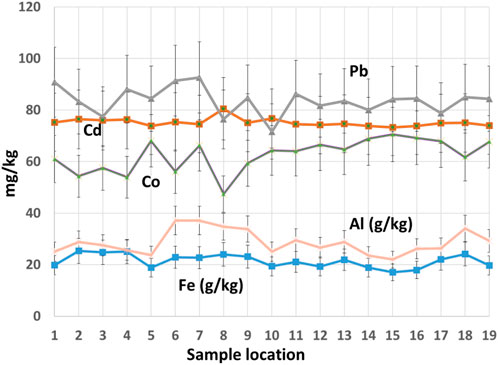
FIGURE 4. Spatial distribution of Al, Fe, Cd, Pb and Co in dusts collected from the Abu Dhabi-Liwa Highway.
Based on abundance, the metal composition of roadside dust decreased in the following order: Al>Fe>Mn>Zn>Cu>Pb>Cd>Co>As>Ni>Cr (Table 2). A high amount of Mn was detected in all samples, irrespective of the sampling site, ranging between 540.6 and 923.9 mg/kg with an average of 711.4 mg/kg (Table 2; Figure 2). A similar finding was reported in roadside dust collected from the Abu Dhabi-Al Ain highway (Al-Taani et al., 2019a), where Mn was the most abundant heavy metal.
Mn in roadway dust links to traffic emissions (Straffelini et al., 2015), where Mn is employed in fuel additives, anticorrosion, and other automobile applications (inner panels, heater, and radiator tubes) (Candeias et al., 2020). Apeagyei et al. (2011) found metal concentrations in brake pads in the following order: Mn>Zn>Pb>Cr>Cd. Previous studies in this region (from Saudi Arabia, Iran, Kuwait, and the UAE) reported significant amounts of Mn in roadside dust (Table 3) and have been attributed to traffic emissions and crustal sources. The EF values of Mn ranged from 2.14 to 3.80 (Table 4), indicating moderate anthropogenic enrichment caused partly by vehicular non-exhaust emissions. Natural sources include atmospheric deposition (Al-Taani et al., 2015a) and weathering of granitic rocks, which may influence Mn content along with Fe, Al, Mg, and Na (Romão et al., 2013). In sampling site 8, road dusts were trapped between the road edge and pavement with high loads, where a peak in the Mn level (as well as Zn, Cr, As, and Cd) was measured. In addition to motor emissions, the application of manure in farms bordering Site 8 and the resuspension of agricultural soil irrigated with sewage water, which is the primary source of irrigation water, are contributing factors to Mn (as well as Zn, Cr, and Cd) (El-Radaideh and Al-Taani, 2018). This is consistent with the relatively high As levels observed in this site, which are linked to the resuspension of agricultural soils with phosphate fertilizers.
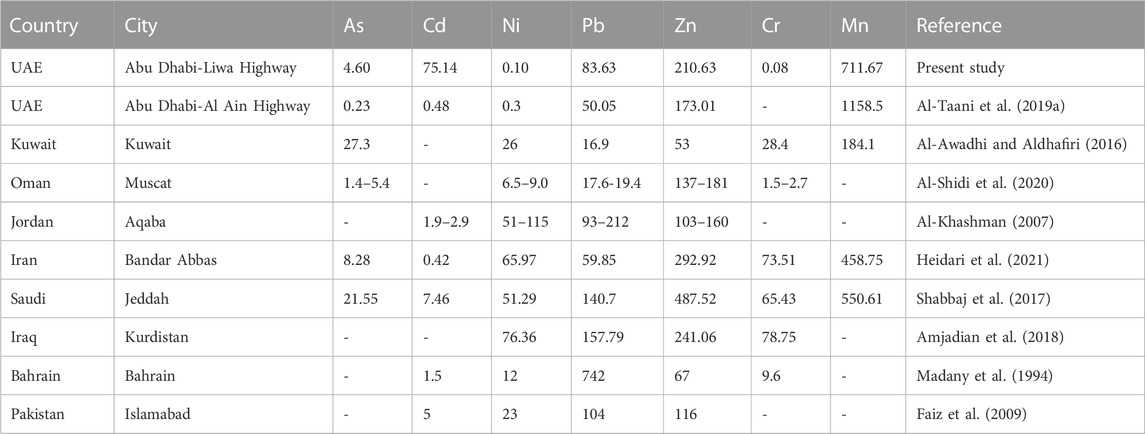
TABLE 3. Heavy metal concentrations (mg/kg) in road dusts reported from different cities in the region.
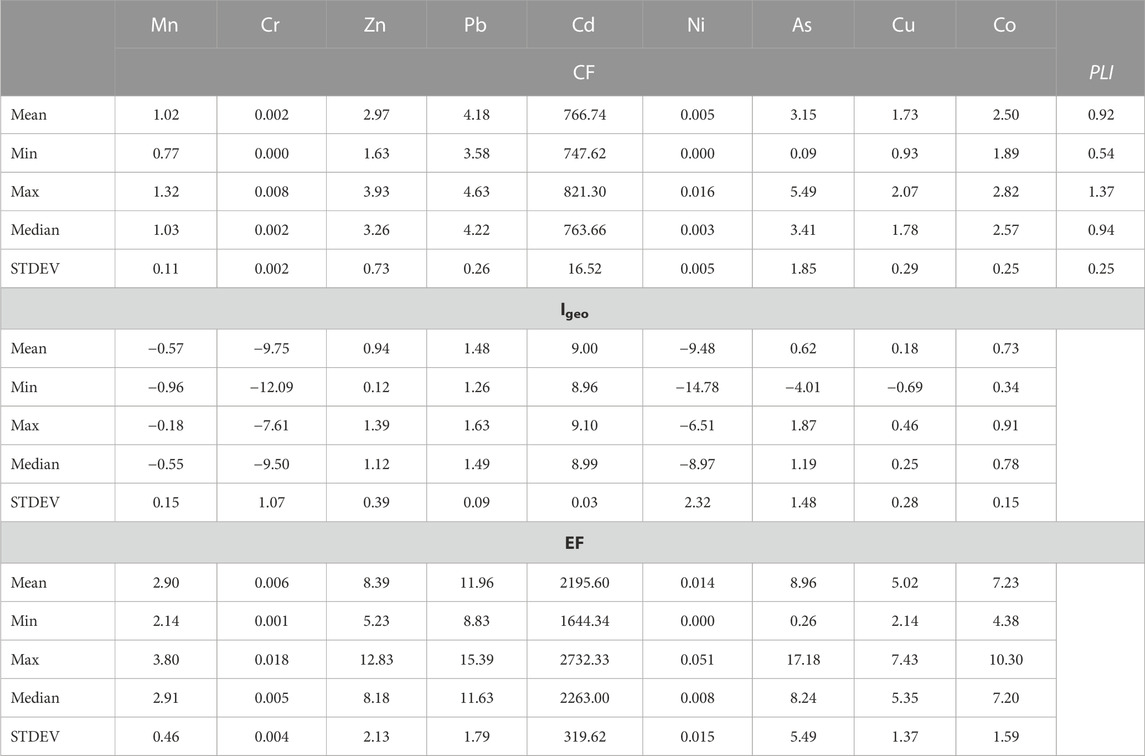
TABLE 4. Summary of the contamination factor (CF) and pollution load index (PLI) for heavy metals in road dust collected from the Abu Dhabi-Liwa Highway.
Zn is the second-most abundant heavy metal in road-deposited dust, with concentrations in the range of 115.9–279.1 mg/kg and an average of 210.6 mg/kg (Figure 2; Table 2). Road dust is significantly enriched in Zn, with enrichment values ranging between 5.2 and 12.8 (Table 4). Similarly, elevated levels of Zn were observed in the neighboring countries with similar traffic flow and an arid climate (frequent dust storms), where 292.92 mg/kg was observed in road dusts in Iran, 241.06 mg/kg in Iraq, 137–181 mg/kg in Oman, and about 487.52 mg/kg were reported from one of the busiest highways in Jeddah, Saudi Arabia (Table 3). Traffic-related materials are an important source of Zn, including tire rubber, brake wear, engine oil additives, and fuel combustion (Sternbeck et al., 2002). Zn is the most abundant metal measured in tires (Apeagyei et al., 2011). Relatively higher concentrations were recorded in sampling locations 4, 8, and 13 (among others) due to road junctions and high traffic volumes, indicating brake and tire wears (Al-Taani et al., 2019a). Resuspended agricultural soils following extensive use of manure and sewage water are an important source of Zn, especially in location 8.
The highway starts at a low-speed traffic zone. The smooth traffic flow with lower velocity and no breaking next to sample 1 is a major factor contributing to the relatively low levels of traffic-related metals observed in this location, particularly Zn, Cd, Ni, and Cr (and partly Mn), as these metals are associated with brake and tire wear, and corrosion of vehicle’s metallic parts (Al-Taani et al., 2015a).
The Abu Dhabi-Liwa Highway is frequently used by heavy trucks, where tire wear generally increases with increasing vehicle weight. This is likely to elevate the non-exhaust traffic-related emissions of metals (Zn, Cr, Cd, and Co) because of increased brake, tire, and road wear (Simons, 2016). The road surface roughness is another important parameter (as observed in this highway from sample site 11 onwards) as it influences the tire wear or friction between the tire and asphalt with subsequent increases in the road surface loads (Amato et al., 2011).
Cu contents varied between 50.97 and 113.85 mg/kg, with a mean concentration of 94.94 mg/kg (Figure 2; Table 2). The variations of Cu levels showed no trends. The EF values in Cu in roadway dust ranged from about 2.1 to 7.3 (Table 4), indicating moderately to significantly enriched dust. Cu has been widely associated with brake wear, tire tread wear, dust emissions (Loganathan et al., 2013), and corrosion of metallic parts (Al-Taani et al., 2015a). These potential sources are relevant for the fine size fractions (Gietl et al., 2010), similar to those collected in this study.
Ni and Cr were the least abundant in dust and soil samples among the metal elements investigated. Ni ranged from 0.001 to 0.328 mg/kg with a mean amount of 0.01 mg/kg, whereas Cr varied between 0.08 and 0.268 mg/kg averaging 0.012 mg/kg (Table 2). The average enrichment index values indicate that Ni and Cr are derived from crustal materials or natural processes (EF<0.05) (Table 4). Low levels of Ni were also reported in the Abu Dhabi-Al Ain Highway dusts at 0.3 mg/kg (Table 3). However, significant concentrations of Ni were measured along major highways in the neighboring countries, with values above 50 mg/kg in Jordan, Iran, Saudi Arabia, and Iraq, 23 mg/kg in Pakistan, and 12 mg/kg in Bahrain (Table 3) and linked to vehicular-related emissions.
Road-deposited dust appeared to be variable in As, with a distinct decreasing trend (Figure 3). As values ranged from 0.14 to 8.24 mg/kg with an average value of 4.73 mg/kg (Table 2; Figure 3). Elevated levels of As were reported from roadside dust in major cities in middle eastern countries, for example, 27.3 mg/kg was found in the city of Kuwait, 8.28 mg/kg in Bandar Abbas (Iran), 21.55 mg/kg in Jeddah (Saudi), and up to 5.4 mg/kg in Muscat (Oman). The As enrichment levels in this study, ranging from 0.26 to 17.18 (Table 4), indicate that only a few sites are predominated by natural sources, whereas the vast majority of As content is attributed to anthropogenic activities. Sampling sites from 1 to 16 are significantly enriched in As, with a spatially decreasing intensity of enrichment toward site 19. The low As content at site 19 exhibited crustal sources with almost non-existent agricultural activities in the vicinity of dust sampling locations. The As rich dust in the study area originates mainly from resuspended agricultural soil as roadside dust samples obtained from sites 2–15 were surrounded by farmlands and cropping areas with excessive use of agrochemicals (fertilizers and pesticides) and biosolids. The UAE is one of the largest consumers of fertilizers, with a consumption rate of 643.4 kg/hectare of arable land in 2020 compared to the world average of 180.1 kg/hectare (Economy, 2020). Arsenic is associated with pesticide application, organic manure, and phosphatic fertilizers (Candeias et al., 2020) commonly used in these farms. In addition to agricultural sources of As in this area, As is originated from motor-related non-exhaust emissions as the elemental As is employed in manufacturing Pb alloys (in Pb–acid batteries) and Cu (Office of Air Quality Planning And Standard, 1998; Agency for Toxic Substances and Disease Registry ATSDR, 2007).
The concentrations of Al and Fe (along with Cd, Pb, and Cu) varied with no distinct trends (Figures 2, 4). Fe and Al ranged from 17005 to 25368 mg/kg and 21969–37135 mg/kg, respectively (Table 2). A significant amount of Fe and Al is related to crustal sources, especially in arid regions (Shahid and Abdelfattah, 2008; Yusuf et al., 2011; Al-Rousan et al., 2016). This is supported by the EF values of Fe (1.1–1.7), which suggest a deficiency due to minimal enrichment and dominant contributions from natural sources for this metal. In addition, Fe and Al originate from the atmospheric deposition of mineral dust and soil sources where dust storms are frequent in this extremely dry region (Al-Taani et al., 2015a).
Highly elevated levels of Cd have been observed, ranging from 73.3 to 80.5 mg/kg, with an average of 75.14 mg/kg (Figure 4; Table 2). The EF values of Cd indicate that road dust samples from the Abu Dhabi–Liwa Highway were extremely highly enriched in Cd (Table 4). Cd (and Pb and Zn) in roadside soils and urban soils are linked to traffic activities (Wiseman et al., 2012; El-Radaideh et al., 2017; Padoan et al., 2017; Yan et al., 2018; Nazzal et al., 2021a). High concentrations of Cd have also been reported in Jeddah (7.46 mg/kg), Aqaba (up to 2.9 mg/kg), and Islamabad (5 mg/kg) (Table 2).
These concentrations of Cd are attributable to multiple human sources. Heavy trucks and high speeds along this highway contribute to increased brake wear, where Cd is used as plating in brake pads to prevent corrosion (Planning, Implementing, and Evaluating Health Promotion Programs, 2008). In addition, Cd is released from diesel fuel (a large number of diesel-fueled tracks use this highway) and vehicle paints (Wahab et al., 2020). In addition, Cd inputs are attributed to resuspended agricultural soil irrigated with sewage water, the use of phosphate fertilizers, and manure (Alloway and Steinnes, 1999; Luo et al., 2009). The peak in Cd observed in sampling location 8 is in close proximity to a rest area for truck drivers. In this area, oil and diesel leakages were found where drivers tend to do some emergency repairs, check-ups, and oil changes. This part of the highway is characterized by congestion and low speed with frequent braking, which is likely to add more Cd (and other heavy metals) to the highway sweepings. High road dust loadings were observed in this area as dust was trapped between the road edge and pavement.
Similar to Cd, all sampling sites detected a substantial amount of Pb content in dust samples. Pb varied between 71.61 mg/kg and 92.62 mg/kg (with a mean value of 83.63 mg/kg) (Figure 4; Table 2). Elevated levels of Pb were measured in road dust deposition in major cities of this region, where 93–212 mg/kg was reported in Aqaba (Jordan), 140.7 mg/kg in Jeddah (Saudi), 157.79 mg/kg in Kurdistan (Iraq), 742 mg/kg in Bahrain, 104 mg/kg in Islamabad (Pakistan), 16.9 mg/kg in Kuwait, and 50.05 mg/kg along the Abu Dhabi–Al Ain road (UAE) (Table 3), with motor-related activities as the primary contributors. The higher values observed in the present study for Pb suggest anthropogenic sources. Moderate to significant levels of enrichment for Pb were obtained for road sweepings ranging from 8.83 to 15.40 (Table 4).
A high content of Pb was found in the dust sampling site 1. This location was chosen in the low-speed traffic zone near a residential area and a temporary truck parking station, where the diesel-powered trucks remain idle while parking with subsequent higher tailpipe emissions of Pb (Al-Taani et al., 2019a). In the vicinity of site 7, a gas station is located, where a relatively high content of Pb was also noticed. Before approaching the gas station, drivers often reduce speeds with minor traffic jams and stop-start maneuvers, causing increases in Zn, Co, and Cu levels.
Pb is used for vehicle wheel balancing, paints, and road surfaces, which may erode, abrade, and accumulate in urban streets (Zafra-Mejía et al., 2011; Zhang et al., 2016; Adamiec, 2017). In addition, Pb (and Cu) is associated with the use of lubricants, and Pb oxide is employed as a component of brake friction materials (Adamiec, 2017). Although Pb was phased out as a gasoline additive in the UAE, it may be observed that Pb is a persistent environmental element (Root, 2000).
Significant amounts of Co for roadway sweepings ranging from 47.4 to 70.5 mg/kg were measured (Figure 4; Table 2). In the absence of other human activities, these high levels suggest a strong anthropogenic contribution from traffic-related emissions, especially brake wear (Amato et al., 2011; Hulskotte et al., 2014). This is evident from the high values of the enrichment index (Table 4), which indicate that road dust is extremely highly enriched in Co. In location 5, road cracks were apparent and higher concentrations of Co were observed. The petroleum-based binding material of asphalt is a potential source of Co (Health Canada, 2017; J. G. Speight, 2016). From location 11 onwards, the highway speed is reduced to 120 km/h, with more road junctions and changes in road conditions as cracks and erosion of asphalt become more frequent, especially at the outer edges of the highway. These are potential contributors to the observed levels of Co, Zn, and partly Cu in dust.
The weight of vehicles is a contributing factor to the metal composition of the dust on the Abu Dhabi-Liwa Highway. Heavy trucks produce larger amounts of non-exhaust emissions as a result of increased brake, tire, and road wear (Simons, 2016). All the metals considered in this study (except arsenic) have been implicated in these non-exhaust emission sources.
A summary of the statistics of metal pollution indices for road dusts is tabulated in Table 4. The CF, Igeo and EF demonstrated generally similar rankings for metals with few exceptions. CF and EF showed identically the same order, Cd> Pb> As> Zn> Co> Cu> Mn> Ni> Cr, whereas the Igeo values revealed minor differences with a descending order of Cd> Pb> Zn> Co> As> Cu> Mn> Ni> Cr (Table 4). Based on EF levels, roadway dusts are enriched in all metals, except for Ni and Cr. This is consistent with CF values, which indicate metal contamination in road deposited dusts, except for Ni and Cr. Similarly, the average Igeo values show differing rates of pollution for all metals except for Mn, Ni, and Cr (Table 4).
The mean CF values show Cd has the highest average CF value of 766.7, whereas the minimum averages were found for Ni and Cr at 0.005 and 0.002, respectively (Table 4), suggesting low/no contamination. The mean CF values of Cd, Pb, As, Zn, Co, Cu, and Mn were above 1, indicating varying degrees of metal pollution relative to the background crust. Roadside dust is moderately contaminated with Mn, Zn, Cu, and Co (1≤CF˂3). The mean CF values of Cd, Pb, and As (CF>3) indicate the persistent elevation of these metals in road dusts, with considerable contamination for Pb and As (3≤CF≤6) and very high contamination levels for Cd (CF˃6) (Table 4).
The PLI values of 1 or greater were observed in road dust collected from sites 1, 2, 3, 4, 6, 8, 9, and 10, suggesting that these sites are polluted. Lower values for PLI were found at site 11, generally decreasing toward the last sampling sites.
The average values of Igeo showed that road-deposited dusts are uncontaminated with Mn (Igeo = −0.57), Cr (Igeo = −9.75), and Ni (Igeo = −9.48); uncontaminated/moderately contaminated with Co (Igeo = 0.73), Zn (Igeo = 0.94), As (Igeo = 0.62), and Cu (Igeo = 0.18); moderately contaminated with Pb (Igeo = 1.48); and extremely contaminated with Cd (Igeo = 9) (Table 4). This is similar to findings in an earlier study on road dust samples in on the Abu Dhabi–Al Ain Highway (Al-Taani et al., 2019a).
Except for Ni and Cr, the average enrichment factors in all dust and soil samples suggest varying enrichment (Table 4). The mean EF values of less than 1 for Ni and Cr indicate depletion and are probably related to the use of upper continental crust as background values, which may not reflect the local reference concentrations. The average value of EF for Cd (>40) indicates extremely high enrichment. The mean EF of Co, Zn, Pb, Cu, and As of greater than 5 categorizes these metals as significantly enriched, whereas the Mn mean EF value of 2.9 is moderately enriched.
Results revealed that the dust collected both from the right and left sides of the Abu Dhabi-Liwa Highway was higher in metal content (as well as dust loads) than that obtained from the central reservation area (Table 5). This highlights the role of road dust resuspension, which is largely driven by high speeds and the flow of vehicles. The maximum speed limit along the Abu Dhabi-Liwa Highway ranges from 120 to 140 km/h. The central reservation area is unprotected, and deposited dusts are more susceptible to turbulence from winds generated by high-speed traffic flow, where they are pushed into traffic lanes. Dust particles deposited on the asphalt are resuspended and uplifted to the roadside area, where they are deposited and accumulated. Farmland in the vicinity acts as a windbreak that reduces the wind speed and forces the windblown dust to deposit. To check whether there are statistically significant differences in heavy metals among these locations (left, right, and central reservation), an analysis of variance (ANOVA) test was used, and the results are summarized in Table 6. The statistical analysis indicates that the differences in the observed values for As, Cu, Zn, Cr, and Mn are statistically significant (at p < 0.05), whereas there are no significant differences in the contents of Cd, Ni, Pb, and Co (with p-values greater than 0.05) (Table 6). This suggests that the sampling locations of roadway dusts are important contributors to the levels and loadings of some heavy metals, in particular, As, Cu, Zn, Cr, and Mn, and that these metals exhibit spatial variations.
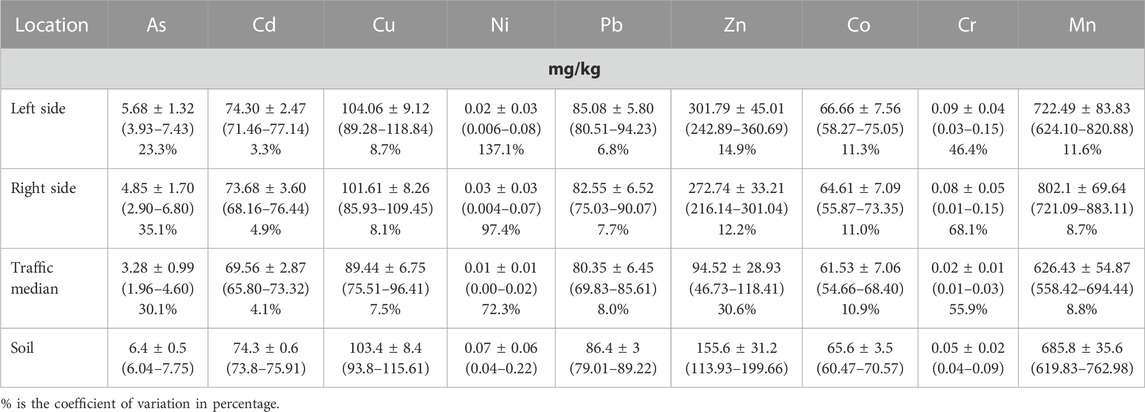
TABLE 5. Heavy metal contents in dust collected from roadsides and traffic median, and soil bordering the Abu Dhabi-Liwa Highway.
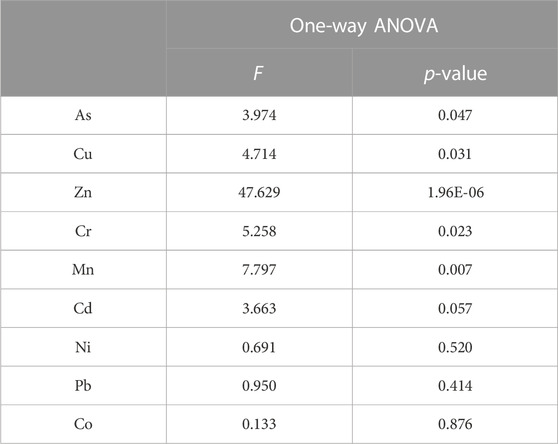
TABLE 6. Statistical analysis (one-way ANOVA) of the heavy metal concentrations (mg/kg) in roadway dust collected from roadsides (left and right) and traffic median along the Abu Dhabi Highway.
In addition, the left side dust illustrated greater levels of metals relative to the right side of the highway, except for Mn (Table 5). This is linked to prevailing southeast wind direction, pushing and transporting airborne dusts enriched in metals further southeast to the left side of the highway, where dust deposits and accumulates as windbreaks reduce wind velocity. Mn is largely of crustal origin (with minor contributions from traffic-related activities, as discussed earlier), which may come from atmospheric mineral dust deposition (Al-Taani et al., 2015b). The composition and loadings of road dust may vary with a range of factors, including the prevailing wind direction, land use, traffic characteristics, topography, the presence of intersections, bridges, and farmlands (Al-Taani et al., 2019a).
Soil samples were obtained to further elaborate on the role of road dust and the long-term accumulation of metals in soils. This is important as farmlands surrounding the highway are vulnerable to metal accumulation, which is likely to affect agricultural soils and products. Selected sites were investigated for heavy metals in the soil next to the highway, and the results are presented in Table 5. The average contents were 6.4, 74.3, 103.4, 0.07, 86.4, 155.6, 65.6, 0.05, and 685.8 mg/kg for As, Cd, Cu, Ni, Pb, Zn, Co, Cr, and Mn, respectively. These values are comparable to those observed for heavy metals in road dust samples (Table 2), with a few exceptions. Soils bordering the highway are vulnerable both to vehicular emissions and to resuspended agricultural soils from intensive use of agrochemicals and treated wastewater. This is especially true for As, Cu, Pb, and Co, where relatively elevated averages were observed in soil samples compared to their respective values in road dust. Mn and Zn revealed greater levels in roadway sweepings than soils (Table 2). These data showed that soils adjacent to the highway tend to accumulate metals, with implications for the quality of agricultural products.
The summary of ionic concentrations (major cations and anions) in roadside dusts is tabulated in Table 7. Elevated levels of Ca, K, Mg, Na, Cl, NO3, and SO4 were found ranging from 172.9 to 333.2, 10.2–23.8, 2.6–14.3, 0.5–90.3, 1.0–6.6, 0.1–2.2, and 0.9–9.7 g/kg, respectively (Table 7). The Ca content is the largest component in road dust in all sampling sites. These salts are largely of geochemical origin (except for nitrate) and have originated from the weathering of naturally occurring evaporites (halite and gypsum) and carbonates (limestone and dolomite), atmospheric deposition, and the surrounding soils.
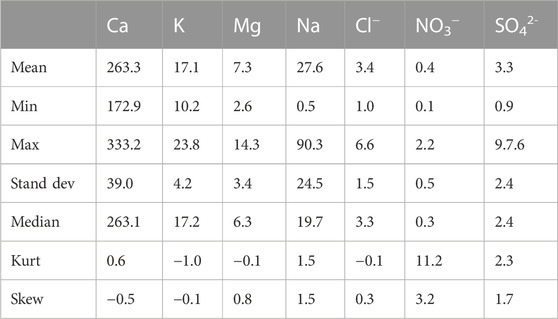
TABLE 7. Concentrations of major cations and anions in dusts sampled from the Abu Dhabi-Liwa Highway (g/kg).
However, eroded road pavement and asphalt materials are minor sources of salts as asphalt usually contains Al, Si, K, and Ca, with smaller amounts of Fe, Mg, and Zn (Gietl et al., 2010). In addition, K can be derived from potassium nitrate fertilizers used in the surrounding farmlands. The consistent appearance of high nitrate content in road dust suggests anthropogenic sources, where nitrate was incorporated into the road dust because of traffic activities. The elevated levels of nitrate were found in samples from adjoining farms, indicating the contribution of the surrounding agricultural land to road dust.
The concentrations of eleven heavy metals, along with major cations and anions, were assessed in Abu Dhabi-Liwa Highway dusts. Metal contents in road-deposited dust appeared to be variable. Although crustal minerals impact the study area, most metals are influenced by natural and anthropogenic sources to varying degrees. The average concentrations of metal decreased in the order Al>Fe>Mn>Zn>Cu>Pb>Cd>Co>As>Ni>Cr. The contamination factor values indicate varying contamination levels, especially with Pb, As, and Cd. The pollution intensity increases up to site 10 before decreasing toward the last sampling site. Based on the geoaccumulation values, dust is broadly contaminated with Pb and Cd. The enrichment factor suggests high enrichment for Cd, Co, Zn, Pb, Cu, and As. Soils appear to be affected by traffic-related emissions of metals. Considerable concentrations of Ca, K, Mg, Na, Cl, and SO4 indicate a strong contribution from natural sources. The consistent appearance of high nitrate content in road dust suggests anthropogenic sources, especially fertilizers, in the surrounding farmlands.
The original contributions presented in the study are included in the article/supplementary material; further inquiries can be directed to the corresponding authors.
Conceptualization, AA-T and YN; methodology, AA-T and AA; validation, MS; formal analysis, CX; investigation, DP; resources, JI and LM; data curation, AA-T and LA; writing—original draft preparation, AA-T; writing—review and editing, HF and IS; visualization, MS; supervision, YN; project administration, YN and FH; funding acquisition, YN and MN.
The study was supported by RIF (R20115) grant by Zayed University to YN.
The authors declare that the research was conducted in the absence of any commercial or financial relationships that could be construed as a potential conflict of interest.
All claims expressed in this article are solely those of the authors and do not necessarily represent those of their affiliated organizations, or those of the publisher, the editors, and the reviewers. Any product that may be evaluated in this article, or claim that may be made by its manufacturer, is not guaranteed or endorsed by the publisher.
Adamiec, E. (2017). Chemical fractionation and mobility of traffic-related elements in road environments. Environ. Geochem. Health 39 (6), 1457–1468. doi:10.1007/S10653-017-9983-9
Agency for Toxic Substances and Disease Registry (ATSDR) (2007). Toxicological profile for arsenic. Available at: https://www.atsdr.cdc.gov/toxprofiles/tp2.pdf.
Al-Awadhi, J. M., and Aldhafiri, B. T. (2016). Heavy metal concentrations in roadside-deposited sediments in Kuwait city. Arabian J. Geosciences 9 (8), 535–614. doi:10.1007/s12517-016-2543-2
Al-Khashman, O. A. (2007). The investigation of metal concentrations in street dust samples in Aqaba city, Jordan. Environ. Geochem. Health 29 (3), 197–207. doi:10.1007/s10653-006-9065-x
Al-Rousan, S., Al-Taani, A. A., and Rashdan, M. (2016). Effects of pollution on the geochemical properties of marine sediments across the fringing reef of Aqaba, Red Sea. Mar. Pollut. Bull. 110 (1), 546–554. doi:10.1016/J.MARPOLBUL.2016.05.038
Al-Shidi, H. K., Al-Reasi, H. A., and Sulaiman, H. (2020). Heavy metals levels in road dust from Muscat, Oman: Relationship with traffic volumes, and ecological and health risk assessments. Int. J. Environ. Health Res. 32 (2), 264–276. doi:10.1080/09603123.2020.1751806
Al-Taani, A. A., Batayneh, A., Nazzal, Y., Ghrefat, H., Elawadi, E., and Zaman, H. (2014). Status of trace metals in surface seawater of the Gulf of Aqaba, Saudi Arabia. Mar. Pollut. Bull. 86, 582–590. doi:10.1016/j.marpolbul.2014.05.060
Al-Taani, A. A., Batayneh, A. T., El-Radaideh, N., Ghrefat, H., Zumlot, T., Al-Rawabdeh, A. M., et al. (2015a). Spatial distribution and pollution assessment of trace metals in surface sediments of Ziqlab Reservoir, Jordan. Environ. Monit. Assess. 187 (2), 32–14. doi:10.1007/s10661-015-4289-9
Al-Taani, A. A., Howari, F., Nazzal, Y., and Yousef, A. (2018). Seasonal impact to air qualities in industrial areas of the Arabian Gulf region. Environ. Eng. Res. 23 (2), 143–149. doi:10.4491/eer.2017.153
Al-Taani, A. A., Nazzal, Y., and Howari, F. M. (2019a). Assessment of heavy metals in roadside dust along the Abu Dhabi–Al Ain national highway, UAE. Environ. Earth Sci. 78 (14), 411. doi:10.1007/s12665-019-8406-x
Al-Taani, A. A., Nazzal, Y., Howari, F., and Yousef, A. (2019b). Long-term trends in ambient fine particulate matter from 1980 to 2016 in United Arab Emirates. Environ. Monit. Assess. 191 (3), 143. doi:10.1007/s10661-019-7259-9
Al-Taani, A. A., Rashdan, M., and Khashashneh, S. (2015b). Atmospheric dry deposition of mineral dust to the Gulf of Aqaba, Red Sea: Rate and trace elements. Mar. Pollut. Bull. 92 (1–2), 252–258. doi:10.1016/J.MARPOLBUL.2014.11.047
Alloway, B. J., and Steinnes, E. (1999). Anthropogenic additions of cadmium to soils. Cadmium Soils Plants, 97–123. doi:10.1007/978-94-011-4473-5_5
Amato, F., Pandolfi, M., Moreno, T., Furger, M., Pey, J., Alastuey, A., et al. (2011). Sources and variability of inhalable road dust particles in three European cities. Atmos. Environ. 45 (37), 6777–6787. doi:10.1016/J.ATMOSENV.2011.06.003
Amjadian, K., Pirouei, M., Rastegari Mehr, M., Shakeri, A., Khurshid Rasool, S., and Ibrahim Haji, D. (2018). Contamination, health risk, mineralogical and morphological status of street dusts-case study: Erbil metropolis, Kurdistan Region-Iraq. Environ. Pollut. 243, 1568–1578. doi:10.1016/J.ENVPOL.2018.09.116
Apeagyei, E., Bank, M., and Spengler, J. (2011). Distribution of heavy metals in road dust along an urban-rural gradient in Massachusetts. Atmos. Environ. - Atmos. Environ. 45, 2310–2323. doi:10.1016/j.atmosenv.2010.11.015
Batayneh, A., Elawadi, E., Zaman, H., Al-Taani, A. A., Nazzal, Y., and Ghrefat, H. (2014). Environmental assessment of the Gulf of Aqaba coastal surface waters, Saudi Arabia. J. Coast. Res. 30, 283–290. doi:10.2112/JCOASTRES-D-13-00112.1
Cai, K., and Li, C. (2019). Street dust heavy metal pollution source apportionment and sustainable management in A typical city—shijiazhuang, China. Int. J. Environ. Res. Public Health 16 (14), 2625. doi:10.3390/IJERPH16142625
Candeias, C., Vicente, E., Tomé, M., Rocha, F., Ávila, P., and Célia, A. (2020). Geochemical, mineralogical and morphological characterisation of road dust and associated health risks. Int. J. Environ. Res. Public Health 17 (5), 1563. doi:10.3390/ijerph17051563
Economy, T. G. (2020). United Arab Emirates fertilizer use. The global economy. Available at: https://www.theglobaleconomy.com/United-Arab-Emirates/fertilizer_use/.
El-Radaideh, N., Al-Taani, A. A., and Al Khateeb, W. M. (2017). Status of sedimentation in king talal dam, case study from Jordan. Environ. Earth Sci. 76 (3), 132–217. doi:10.1007/s12665-017-6426-y
El-Radaideh, N., Al-Taani, A. A., Momani, T., Tarawneh, K., Batayneh, A., and Taani, A. (2014). Evaluating the potential of sediments in Ziqlab Reservoir (northwest Jordan) for soil replacement and amendment. Lake Reserv. Manag. 30, 32–45. doi:10.1080/10402381.2013.870263
El-Radaideh, N. M., and Al-Taani, A. A. (2018). Geo-environmental study of heavy metals of the agricultural highway soils, NW Jordan. Arabian J. Geosciences 11 (24), 787–814. doi:10.1007/s12517-018-4099-9
Faiz, Y., Tufail, M., Javed, M. T., Chaudhry, M. M., and Naila-Siddique., (2009). Road dust pollution of Cd, Cu, Ni, Pb and Zn along Islamabad expressway, Pakistan. Microchem. J. 92 (2), 186–192. doi:10.1016/J.MICROC.2009.03.009
Gietl, J. K., Lawrence, R., Thorpe, A. J., and Harrison, R. M. (2010). Identification of brake wear particles and derivation of a quantitative tracer for brake dust at a major road. Atmos. Environ. 44 (2), 141–146. doi:10.1016/J.ATMOSENV.2009.10.016
Hakanson, L. (1980). An ecological risk index for aquatic pollution control.a sedimentological approach. Water Res. 14 (8), 975–1001. doi:10.1016/0043-1354(80)90143-8
Health Canada (2017). Screening assessment; Cobalt and cobalt-containing Substances (environment and climate change Canada, ed.). Health Canada. Available at: https://www.ec.gc.ca/ese-ees/DCEB359C-245F-4A06-B2E5-62887D47C806/EN_Cobalt FSAR FINAL mai 25 2017.pdf.
Heidari, M., Darijani, T., and Alipour, V. (2021). Heavy metal pollution of road dust in a city and its highly polluted suburb; quantitative source apportionment and source-specific ecological and health risk assessment. Chemosphere 273, 129656. doi:10.1016/J.CHEMOSPHERE.2021.129656
Hulskotte, J. H. J., Roskam, G. D., and Denier van der Gon, H. A. C. (2014). Elemental composition of current automotive braking materials and derived air emission factors. Atmos. Environ. 99, 436–445. doi:10.1016/J.ATMOSENV.2014.10.007
Loganathan, A., Schloithe, A. C., Hakendorf, P., Liyanage, C. M., Costa, M., and Wattchow, D. (2013). Prolonged pudendal nerve terminal motor latency is associated with decreased resting and squeeze pressures in the intact anal sphincter. Colorectal Dis. 15 (11), 1410–1415. doi:10.1111/CODI.12368
Luo, L., Ma, Y., Zhang, S., Wei, D., and Zhu, Y. G. (2009). An inventory of trace element inputs to agricultural soils in China. J. Environ. Manag. 90 (8), 2524–2530. doi:10.1016/J.JENVMAN.2009.01.011
Madany, I. M., Salim Akhter, M., and Al Jowder, O. A. (1994). The correlations between heavy metals in residential indoor dust and outdoor street dust in Bahrain. Environ. Int. 20 (4), 483–492. doi:10.1016/0160-4120(94)90197-X
Maloukh, L., Nazzal, Y., Kumarappan, A., Howari, F., Ambika, L. K., Yahmadi, R., et al. (2023). Metagenomic analysis of the outdoor dust microbiomes: A case study from Abu Dhabi, UAE. Atmosphere 14, 327. doi:10.3390/atmos14020327
Mueller, G., Yahya, A., and Gentner, P. (1993). Heavy metal contamination of the sediments of the river Neckar and its tributaries Stocktaking 1990 and comparison with previous investigations. Available at: http://inis.iaea.org/search/search.aspx?orig_q=RN:26020489.
Nazzal, Y., Barbulescu, A., Howari, F., Al-Taani, A. A., Iqbal, J., Xavier, C. M., et al. (2021a). Assessment of metals concentrations in soils of Abu Dhabi emirate using pollution indices and multivariate statistics. Toxics 9 (5), 95. doi:10.3390/toxics9050095
Nazzal, Y., Barbulescu, A., Howari, F., Yousef, A., Al-Taani, A. A., Al Aydaroos, F., et al. (2019). New insights on sand dust storm from historical records, UAE. Arabian J. Geosciences 12 (13), 396. doi:10.1007/s12517-019-4555-1
Nazzal, Y., Orm, N. B., Barbulescu, A., Howari, F., Sharma, M., Badawi, A. E., et al. (2021b). Study of atmospheric pollution and health risk assessment: A case study for the sharjah and ajman Emirates (UAE). Atmosphere 12 (11), 1442. doi:10.3390/ATMOS12111442
Office of Air Quality Planning And Standard (1998). Locating potential sources of arsenic and arsenic compounds. USEPA, 8–16. Available at: https://www.epa.gov/sites/default/files/2020-11/documents/arsenic_and_arsenic_compounds.pdf.
Padoan, E., Romè, C., and Ajmone-Marsan, F. (2017). Bioaccessibility and size distribution of metals in road dust and roadside soils along a peri-urban transect. Sci. Total Environ. 601–602, 89–98. doi:10.1016/J.SCITOTENV.2017.05.180
Petersen, G. (1999). Airborne heavy metals over europe: Emissions, long-range transport and deposition fluxes to natural ecosystems. Contam. For., 123–132. doi:10.1007/978-94-011-4694-4_14
Planning, implementing, and evaluating health promotion programs (2008). (testimony of brad L. Neiger, james F McKenzie, and thackeray rosemary).
Romão, J., Metodiev, D., Dias, R., and Ribeiro, A. (2013). Evolução geodinâmica dos sectores meridionais da Zona Centro-Ibérica. Geol. Port. 1, 206–257.
Root, R. A. (2000). Lead loading of urban streets by motor vehicle wheel weights. Environ. Health Perspect. 108 (10), 937–940. doi:10.1289/EHP.00108937
Shabbaj, I. I., Alghamdi, M. A., Shamy, M., Hassan, S. K., Alsharif, M. M., and Khoder, M. I. (2017). Risk assessment and implication of human exposure to road dust heavy metals in Jeddah, Saudi Arabia. Int. J. Environ. Res. Public Health 15 (1), 36. doi:10.3390/IJERPH15010036
Shahid, S., and Abdelfattah, M. (2008). Terrestrial environment of Abu Dhabi emirate. Abu Dhabi: Environment Agency, 71–91.
Simons, A. (2016). Road transport: New life cycle inventories for fossil-fuelled passenger cars and non-exhaust emissions in ecoinvent v3. Int. J. Life Cycle Assess. 21 (9), 1299–1313. doi:10.1007/s11367-013-0642-9
Speight, J. G. (2016). Chapter 12 - environmental aspects of asphalt use. (Butterworth-Heinemann), 475–511. doi:10.1016/B978-0-12-800273-5.00012-X
Sternbeck, J., Sjödin, Å., and Andréasson, K. (2002). Metal emissions from road traffic and the influence of resuspension—Results from two tunnel studies. Atmos. Environ. 36 (30), 4735–4744. doi:10.1016/S1352-2310(02)00561-7
Straffelini, G., Ciudin, R., Ciotti, A., and Gialanella, S. (2015). Present knowledge and perspectives on the role of copper in brake materials and related environmental issues: A critical assessment. Environ. Pollut. 207, 211–219. doi:10.1016/J.ENVPOL.2015.09.024
Tomlinson, D., Wilson, J., Harris, C. R., and Jeffrey, D. W. (1980). Problems in the assessment of heavy-metal levels in estuaries and the formation of a pollution index. Helgoländer Meeresunters. 33, 566–575. doi:10.1007/BF02414780
Wahab, M. I. A., Razak, W. M. A. A., Sahani, M., and Khan, M. F. (2020). Characteristics and health effect of heavy metals on non-exhaust road dusts in Kuala Lumpur. Sci. Total Environ. 703, 135535. doi:10.1016/J.SCITOTENV.2019.135535
Wiseman, C., Zereini, F., and Püttmann, W. (2012). Traffic-related trace element fate and uptake by plants cultivated in roadside soils in Toronto, Canada. Sci. Total Environ. 442C, 86–95. doi:10.1016/j.scitotenv.2012.10.051
Yan, G., Mao, L., Liu, S., Mao, Y., Ye, H., Huang, T., et al. (2018). Enrichment and sources of trace metals in roadside soils in shanghai, China: A case study of two urban/rural roads. Sci. Total Environ. 631–632, 942–950. doi:10.1016/J.SCITOTENV.2018.02.340
Yardley, B. W. D. (1986). The continental crust: Its composition and evolution by S. R. Taylor and S. M. McClennan, blackwell scientific publications, oxford, 1985. No. Of pages: 312 + XV pp. Price: £16.80 (soft covers). Geol. J. 21 (1), 85–86. doi:10.1002/gj.3350210116
Yongming, H., Peixuan, D., Junji, C., and Posmentier, E. S. (2006). Multivariate analysis of heavy metal contamination in urban dusts of Xi’an, Central China. Sci. Total Environ. 355 (1–3), 176–186. doi:10.1016/J.SCITOTENV.2005.02.026
Yusuf, N., Al-Taani, A. A., Al-Fukaha, F., Al Shereideh, S., and Mahasneh, M. (2011). Sediments transport across the fringing reef in the Gulf of Aqaba, red sea and the implications on live corals. Abhath Al-Yarmouk 20, 35–52.
Zafra-Mejía, C., Temprano, J., and Monzón, I. (2011). Distribution of the concentration of heavy metals associated with the sediment particles accumulated on road surfaces. Environ. Technol. 32, 997–1008. doi:10.1080/09593330.2010.523436
Keywords: metals, dust, highway, Abu Dhabi, pollution indicators
Citation: Al-Taani AA, Nazzal Y, Howari FM, Iqbal J, Naseem M, Sharma M, Xavier C, Papandreou D, Maloukh L, Ambika L, Ben Salem I, Al Bsoul A and Farok HM (2023) Metal composition and contamination assessment of urban roadway dusts on the Abu Dhabi-Liwa Highway, UAE. Front. Environ. Sci. 11:1157101. doi: 10.3389/fenvs.2023.1157101
Received: 02 February 2023; Accepted: 04 April 2023;
Published: 18 April 2023.
Edited by:
Carl Mitchell, University of Toronto Scarborough, CanadaReviewed by:
Mostafa Yuness Abdelfatah Mostafa, Minia University, EgyptCopyright © 2023 Al-Taani, Nazzal, Howari, Iqbal, Naseem, Sharma, Xavier, Papandreou, Maloukh, Ambika, Ben Salem, Al Bsoul and Farok. This is an open-access article distributed under the terms of the Creative Commons Attribution License (CC BY). The use, distribution or reproduction in other forums is permitted, provided the original author(s) and the copyright owner(s) are credited and that the original publication in this journal is cited, in accordance with accepted academic practice. No use, distribution or reproduction is permitted which does not comply with these terms.
*Correspondence: Ahmed A. Al-Taani, QWhtZWQuQWwtVGFhbmlAenUuYWMuYWU=; Abeer Al Bsoul, ZHIuYWJlZXJhbGJzb3VsQGJhdS5lZHUuam8=
Disclaimer: All claims expressed in this article are solely those of the authors and do not necessarily represent those of their affiliated organizations, or those of the publisher, the editors and the reviewers. Any product that may be evaluated in this article or claim that may be made by its manufacturer is not guaranteed or endorsed by the publisher.
Research integrity at Frontiers

Learn more about the work of our research integrity team to safeguard the quality of each article we publish.